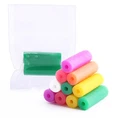As a supplier of barrier films, I often encounter questions from customers about the various properties of our products. One of the most frequently asked questions is about the heat - sealability of barrier films. In this blog, I will delve into what heat - sealability means for barrier films, its importance, factors affecting it, and how we ensure high - quality heat - sealability in our products.
What is Heat - Sealability of Barrier Film?
Heat - sealability refers to the ability of a barrier film to be sealed to itself or another substrate when heat is applied. When heat is introduced, the polymer materials in the film reach a state where they become soft and sticky. Under pressure, these softened polymers fuse together, creating a strong and reliable seal. This is a crucial property for barrier films, as it allows them to be used in a wide range of packaging applications.
For example, in the food packaging industry, barrier films are used to keep food fresh by preventing the ingress of oxygen, moisture, and other contaminants. A proper heat - seal ensures that the package remains airtight, extending the shelf - life of the food product. In the medical field, barrier films are used to package sterile medical devices. The heat - seal must be strong enough to maintain the sterility of the contents until the package is opened.
Importance of Heat - Sealability
The importance of heat - sealability in barrier films cannot be overstated. First and foremost, it provides a reliable way to enclose products. A well - sealed package protects the contents from external factors such as dust, bacteria, and moisture. This is especially important for products that are sensitive to environmental conditions, like pharmaceuticals, electronics, and perishable food items.
Secondly, heat - sealing enhances the convenience of packaging. It allows for quick and efficient packaging processes on high - speed production lines. Manufacturers can seal multiple packages in a short period, increasing productivity and reducing costs.
Thirdly, a good heat - seal provides tamper - evidence. If a package has been opened, the seal is broken, and it is obvious to the consumer. This helps to build trust between the manufacturer and the end - user.
Factors Affecting Heat - Sealability
Several factors can affect the heat - sealability of barrier films.
Polymer Composition
The type of polymers used in the barrier film plays a significant role. Different polymers have different melting points and flow properties. For example, polyethylene (PE) is a commonly used polymer in barrier films due to its excellent heat - sealability. It has a relatively low melting point, which allows for easy sealing at moderate temperatures. On the other hand, polypropylene (PP) has a higher melting point and may require more heat to achieve a proper seal.


Film Thickness
The thickness of the barrier film can also impact heat - sealability. Thicker films generally require more heat and pressure to seal effectively. If the film is too thick, the heat may not penetrate evenly, resulting in a weak or inconsistent seal. Conversely, if the film is too thin, it may not provide enough material for a strong bond, and the seal may be prone to breaking.
Surface Treatment
The surface of the barrier film can be treated to improve heat - sealability. For instance, corona treatment is often used to increase the surface energy of the film. This makes it easier for the polymers to adhere to each other during the sealing process. Another surface treatment is the application of a heat - sealable coating. These coatings are designed to melt at lower temperatures, facilitating the sealing process.
Sealing Conditions
The sealing conditions, including temperature, pressure, and sealing time, are critical. The temperature must be high enough to melt the polymers but not so high that it causes the film to degrade. The pressure applied during sealing should be sufficient to ensure good contact between the sealing surfaces. If the pressure is too low, the seal may be weak; if it is too high, it may damage the film. The sealing time also needs to be optimized. Too short a time may result in an incomplete seal, while too long a time may cause over - melting and distortion of the film.
Our Approach to Ensuring High - Quality Heat - Sealability
As a barrier film supplier, we take several steps to ensure that our products have excellent heat - sealability.
Polymer Selection
We carefully select the polymers used in our barrier films. We work with high - quality raw materials and choose polymers that are known for their good heat - seal properties. We also conduct extensive research and development to optimize the polymer blends to meet the specific requirements of different applications.
Precision Manufacturing
Our manufacturing process is highly precise. We control the film thickness within a narrow tolerance range to ensure consistent heat - sealability. We use advanced extrusion and coating technologies to produce films with uniform properties.
Surface Treatment
We offer a variety of surface treatments to enhance heat - sealability. Our corona treatment equipment is calibrated regularly to ensure optimal surface energy. We also develop and apply high - performance heat - sealable coatings that are tailored to different customer needs.
Quality Control
We have a rigorous quality control system in place. Before our products are shipped to customers, they undergo a series of tests to evaluate their heat - sealability. We use specialized equipment to measure the seal strength, peel resistance, and other relevant parameters. Only products that meet our strict quality standards are released for sale.
Applications of Heat - Sealable Barrier Films
Heat - sealable barrier films have a wide range of applications.
Food Packaging
In the food industry, these films are used to package a variety of products, including fresh produce, meat, cheese, and snacks. The heat - seal creates an airtight environment that keeps the food fresh and prevents spoilage. For example, vacuum - sealed packages of deli meats use heat - sealable barrier films to maintain the quality of the product.
Medical Packaging
Medical devices and pharmaceutical products require sterile packaging. Heat - sealable barrier films are used to create sealed packages that protect the contents from contamination. These films can be sterilized using methods such as gamma radiation or ethylene oxide, and the heat - seal ensures that the sterility is maintained until the package is opened.
Electronics Packaging
Electronics are sensitive to moisture and static electricity. Heat - sealable barrier films can be used to package electronic components, protecting them from environmental damage. The films can also be designed to have anti - static properties to prevent electrostatic discharge.
Contact Us for Your Barrier Film Needs
If you are in the market for high - quality heat - sealable barrier films, we are here to help. Our team of experts can work with you to understand your specific requirements and recommend the most suitable products. Whether you need films for food packaging, medical applications, or electronics, we have the solutions.
We offer competitive pricing, reliable delivery, and excellent customer service. To learn more about our Barrier Film products and to discuss your purchasing needs, please reach out to us. We look forward to starting a productive partnership with you.
References
- Modern Plastics Encyclopedia. McGraw - Hill.
- Packaging Technology and Science. Wiley.
- Journal of Applied Polymer Science. Wiley.




